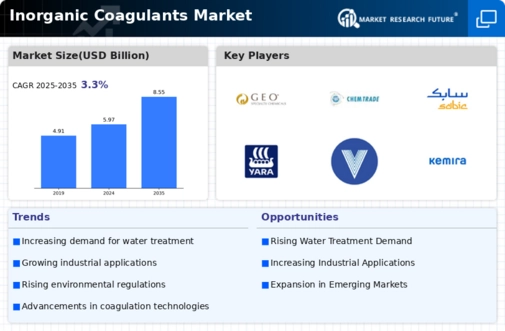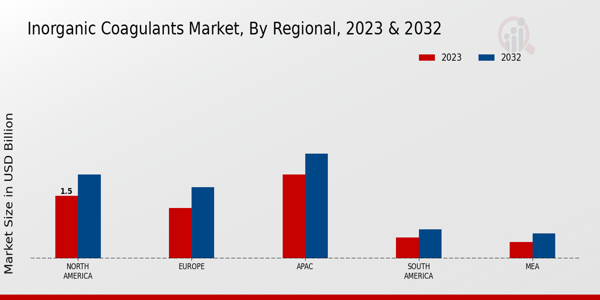Market Growth Projections
The Global Inorganic Coagulants Market Industry is characterized by promising growth projections, reflecting the increasing demand for water treatment solutions. The market is anticipated to reach 5.97 USD Billion in 2024, with a robust CAGR of 3.32% expected from 2025 to 2035. This growth trajectory is indicative of the expanding applications of inorganic coagulants across various sectors, including municipal, industrial, and agricultural. As the global focus on water quality and environmental sustainability intensifies, the market is likely to evolve, adapting to new challenges and opportunities in the water treatment landscape.
Growing Awareness of Water Quality Issues
The Global Inorganic Coagulants Market Industry benefits from the rising awareness of water quality issues among consumers and industries alike. As public concern regarding water pollution and its health implications grows, there is a heightened demand for effective water treatment solutions. This awareness drives municipalities and industries to invest in inorganic coagulants to ensure the safety and quality of water supplies. The market is expected to witness sustained growth, with a projected value of 8.55 USD Billion by 2035. This trend underscores the importance of addressing water quality challenges, as stakeholders recognize the critical role of coagulants in achieving clean water objectives.
Rising Industrialization and Urbanization
The Global Inorganic Coagulants Market Industry is poised for growth due to the rapid industrialization and urbanization occurring globally. As industries expand and urban populations increase, the demand for clean water and effective wastewater treatment solutions intensifies. Inorganic coagulants are essential in various applications, including municipal water treatment and industrial processes. This trend is expected to contribute to the market's expansion, with projections indicating a value of 5.97 USD Billion in 2024. The increasing pressure on water resources necessitates the adoption of efficient treatment solutions, positioning inorganic coagulants as a vital component in addressing these challenges.
Technological Advancements in Water Treatment
Technological innovations play a crucial role in the Global Inorganic Coagulants Market Industry, enhancing the efficiency and effectiveness of water treatment processes. Advances in coagulation technologies, such as the development of new formulations and application methods, are likely to improve the performance of inorganic coagulants. These innovations not only optimize the treatment process but also reduce operational costs for water treatment facilities. As the industry evolves, the integration of smart technologies and automation may further drive growth, aligning with the projected CAGR of 3.32% from 2025 to 2035, as stakeholders seek to enhance productivity and sustainability.
Increasing Demand for Water Treatment Solutions
The Global Inorganic Coagulants Market Industry experiences heightened demand due to the growing necessity for effective water treatment solutions. As urbanization accelerates, the need for clean water becomes paramount. In 2024, the market is projected to reach 5.97 USD Billion, driven by municipal and industrial sectors seeking to comply with stringent water quality regulations. Inorganic coagulants, such as aluminum sulfate and ferric chloride, are favored for their efficiency in removing impurities from water. This trend indicates a robust growth trajectory, as the industry adapts to evolving environmental standards and public health concerns.
Regulatory Compliance and Environmental Standards
The Global Inorganic Coagulants Market Industry is significantly influenced by stringent regulatory frameworks aimed at ensuring water quality and environmental protection. Governments worldwide are implementing regulations that mandate the treatment of wastewater and industrial effluents before discharge. This regulatory landscape compels industries to adopt inorganic coagulants, which are effective in meeting compliance standards. As a result, the market is expected to grow steadily, with a projected value of 8.55 USD Billion by 2035. The increasing focus on sustainable practices further reinforces the demand for these coagulants, as they contribute to reducing environmental impact.











